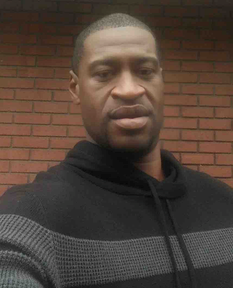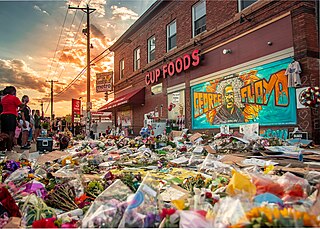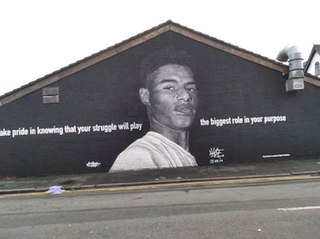Related Research Articles
Public art is art in any media whose form, function and meaning are created for the general public through a public process. It is a specific art genre with its own professional and critical discourse. Public art is visually and physically accessible to the public; it is installed in public space in both outdoor and indoor settings. Public art seeks to embody public or universal concepts rather than commercial, partisan or personal concepts or interests. Notably, public art is also the direct or indirect product of a public process of creation, procurement, and/or maintenance.

Banksy is a pseudonymous England-based street artist, political activist and film director whose real name and identity remain unconfirmed and the subject of speculation. Active since the 1990s, his satirical street art and subversive epigrams combine dark humour with graffiti executed in a distinctive stenciling technique. His works of political and social commentary have appeared on streets, walls and bridges throughout the world. Banksy's work grew out of the Bristol underground scene, which involved collaborations between artists and musicians. Banksy says that he was inspired by 3D, a graffiti artist and founding member of the musical group Massive Attack.

Street art is visual art created in public locations for public visibility. It has been associated with the terms "independent art," "post-graffiti", "neo-graffiti" and guerrilla art.
The year 2020 in art involved various significant events.

The George Floyd protests were a series of police brutality protests that began in Minneapolis in the United States on May 26, 2020. The civil unrest and protests began as part of international reactions to the murder of George Floyd, a 46-year-old African American man who was murdered during an arrest after Derek Chauvin, a Minneapolis Police Department officer, knelt on Floyd's neck for 9 minutes and 29 seconds as three other officers looked on and prevented passers-by from intervening. Chauvin and the other three officers involved were later arrested. In April 2021, Chauvin was found guilty of second-degree unintentional murder, third-degree murder, and second-degree manslaughter. In June 2021 Chauvin was sentenced to 22.5 years in prison with possibility of supervised release after 15 years for second-degree murder.

George Perry Floyd Jr. was an African-American man who was murdered by a police officer in Minneapolis, Minnesota, during an arrest made after a store clerk suspected Floyd may have used a counterfeit twenty-dollar bill, on May 25, 2020. Derek Chauvin, one of the four police officers who arrived on the scene, knelt on Floyd's neck and back for 9 minutes and 29 seconds which caused a lack of oxygen. After his murder, protests against police brutality, especially towards black people, quickly spread across the United States and globally. His dying words, "I can't breathe," became a rallying slogan.

The Black Lives Matter movement has been depicted and documented in various artistic forms and mediums including film, song, television, and the visual arts. In some instances this has taken place in the form of protest art. These cultural representations have also grown organically among artists who seek to partake in activist efforts in support or in recognition of the Black Lives Matter movement. The themes conveyed in these artistic works address the history of racism and injustice toward people of color in the United States and typically express sentiments of anger and fear as well as solace and hope.

A wave of civil unrest in the United States, initially triggered by the murder of George Floyd during his arrest by Minneapolis police officers on May 25, 2020, led to riots and protests against systemic racism in the United States, such as in the form of police violence and other forms of violence. Since then, numerous other incidents of police brutality have drawn continued attention and unrest in various parts of the country.
Many artworks related to the Black Lives Matter movement were created in Portland, Oregon, United States, during local protests over the murder of George Floyd and other Black Americans. Oregon Arts Watch contextualized the artistic works, stating that a "whitewashed pre-COVID lens" on American life, which obscured systemic racism, had been "cracked", and describing artists' response to racial violence being brought into the public eye was a "marathon, not a sprint".

Many artworks related to the Black Lives Matter movement have been created. These works are either seen as a direct tribute to those who have died or more broadly to the movement. Often the pieces are created in the streets as to be more publicly visible. As such several attempts have been made at preserving the art created in protest on the basis of their artistic merit and cultural significance. Increasingly, the erasure of the artwork has been a problem for preservationists. As such, the artworks below represent a fraction of the works created.

The George Floyd Square occupied protest is centered at the intersection of East 38th Street and Chicago Avenue in Minneapolis, Minnesota, United States and features several makeshift memorials and street art. The street intersection is where Derek Chauvin, a White police officer with the Minneapolis Police Department, murdered George Floyd, an unarmed 46-year-old Black man, on May 25, 2020. The day after Floyd's murder, people began leaving memorials to him. The street intersection soon transitioned to a controversial occupation protest by people who had erected barricades to block vehicular traffic and transformed the space with amenities, social services, and public art of Floyd and that of other racial justice themes. The unofficial memorial and occupied protest zone was referred to as “autonomous”, "no-go", and "police-free", but local officials disputed such characterizations.
The Murals of Kyiv are a series of murals painted on the sides of buildings in Kyiv, Ukraine since 2014 which depict both modern and traditional art. Upwards of 160 murals are spread out across the entire city over an area of approximately 285 square kilometers. These murals are not funded by the government, but are instead funded by independent sponsors or art groups.

The Black Lives Matter street muralin Indianapolis is a large, colorful mural reading "#BLACKLIVESMATTER", with a raised fist, that 18 artists painted across a downtown roadway in August 2020, as part of the George Floyd protests. The mural is located on Indiana Avenue, the historic hub of the city's Black culture, on the same corner as the Madam C. J. Walker Building.

In 2020, a mural of footballer Marcus Rashford by street artist Akse P19 was painted in the Withington area of Manchester, United Kingdom. The mural was created in recognition of the work Rashford did during the COVID-19 pandemic in the United Kingdom to help tackle child food poverty.
A mural of George Floyd was painted by Emma Berger outside Portland, Oregon's Apple Pioneer Place, on June 1, 2020, a week after his murder, against the background of the ongoing protests against police brutality. She expanded the mural to show Ahmaud Arbery and Breonna Taylor and phrases associated with the Black Lives Matter movement. The work was vandalized in August, and repaired by the artist. It was covered by Apple Inc. in December for preservation, then removed in January 2021 to be donated to Don't Shoot PDX.

Many artworks related to the Black Lives Matter movement were created in New York City, during local protests over the murder of George Floyd and other Black Americans.
Memorials to George Floyd commemorate the African American man who was murdered by a Minneapolis police officer on May 25, 2020.
George Floyd was an African American man who was murdered by a Minneapolis police officer on May 25, 2020. He was memorialized via events, protests, artwork installations, organizations, official designations, and campaigns.
Save the Boards is an American nonprofit organization based in Minneapolis that collects and preserves street art that emerged during local protests of the murder of George Floyd in 2020.
References
- 1 2 3 4 5 Harris, Sonya (August 31, 2020). "This Digital Archive Allows You To See George Floyd Street Art". mymodernmet.com. Retrieved May 23, 2021.
- 1 2 3 4 Uwagwu, Chioma; Daniels; Lawrence (August 26, 2020). "Art and Uprising: The George Floyd and Anti-Racist Street Art Database". National Museum of American History. Archived from the original on September 4, 2020. Retrieved May 23, 2021.
- 1 2 "George Floyd's death sparks street art movement". CBS News. May 21, 2021. Retrieved May 23, 2021.